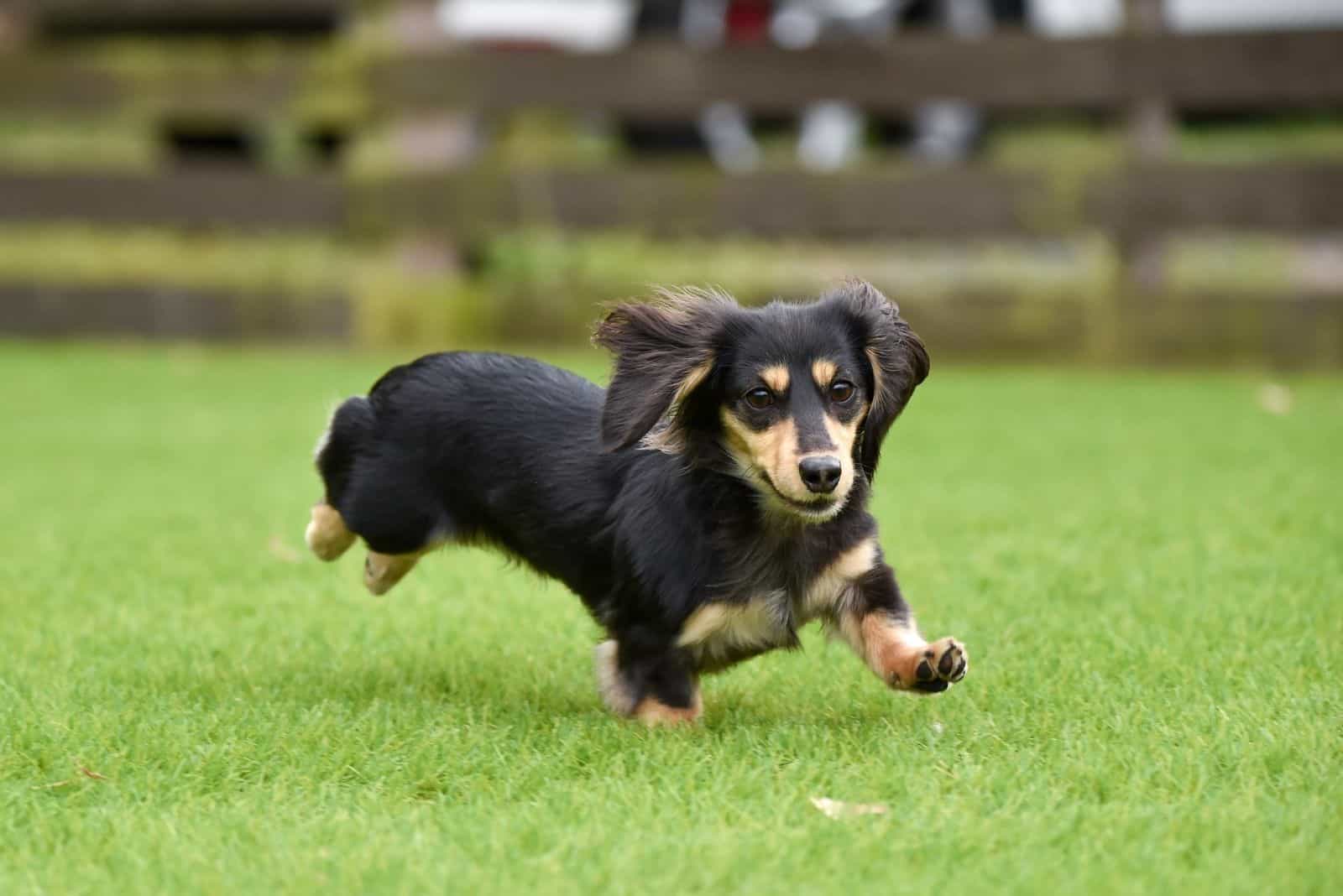The Dachshund was created in Germany where it was known as the badger dog (dachs meaning badger, and hund meaning dog).
Plucky and alert, the Dachshund has short legs, a long body, and a surprisingly loud bark. Their cute appearance and lively disposition have inspired many affectionate nicknames for the breed, including wiener dog, hot dog, sausage dog, Doxie, Dashie etc.
In the context of a Dachshund’s lifespan, Dachshunds generally live a long life compared with other dog breeds (the average lifespan of a Great Dane is only six to eight years, for example).
If you are curious to know how long your Dachshund will live, then this article is for you. There are many factors that influence a dog’s life expectancy.
Read on to find out whether male or female Dachshunds live longer, how to help prolong your Dachshund’s life, and what are common health issues of this small dog.
But, before we give you all the important facts about a Dachshund’s lifespan, let’s find out more about the Dachshund breed.
Dachshund – Short Breed Overview

The Dachshund is a small scent hound dog with short legs and a distinctively elongated body. The breed’s beginning can be traced to the 1600s, when it was used in Germany to hunt, track, and retrieve burrow-dwelling animals, mainly badgers.
The breed was refined over the course of many years by German foresters in the 18th and 19th centuries. They wanted to develop a fearless, elongated dog that could dig into badger burrows, and then go into the burrows to fight the badger to its death if necessary.
Carefully sculpted through years of breeding, today, Dachshunds are the only AKC-recognized breed that hunts both above and below ground. The American Kennel Club recognized Dachshunds in 1885.
Today, this breed is one of the most popular breeds in the United States and elsewhere, and it can be found in the fields as hunting companions or in homes as a family pet.
The Dachshund breed comes in three varieties: smooth Dachshunds (short-haired), wirehaired Dachshunds, and longhaired Dachshunds.
In the United States, there are two varieties: miniature Dachshunds (11 pounds and under as an adult), and standard Dachshunds (usually between 16 and 32 pounds as an adult).

Photo from: @dachshund_couture
Dachshunds have a reputation for being entertaining and fearless, but what they want most is to cuddle with their people. They often bond closely with a single person.
These dogs may even become jealous of their owner’s attention and can, if not properly trained and socialized, become snappy.
The Dachshund’s personality can also vary with its coat type. Because wirehaired Dachshunds have a terrier in their background, they can be mischievous troublemakers.
Longhairs are calm and quiet, and Smooths have a personality that lies somewhere in between. Some Mini Dachshunds can be nervous or shy, but this isn’t correct for the breed.
Because of their size, these little dogs can adapt to apartment living or city life. Still, this breed needs daily exercise and opportunities to spend their energy.
Physical games in the yard or at the park and daily leash walks will keep them in top shape, and will allow them to relax when they are at home.
These dogs are described as clever, lively, and courageous to the point of rashness. They are bred for perseverance, which is another way of saying that they can be stubborn.
Average Dachshund Lifespan: How Long Do Dachshunds Live?

Dachshunds are actually in the top ten breeds that live the longest. They, along with other small dogs such as Pomeranians, Shih Tzus, and Chihuahuas, tend to live longer because they’re small in size.
Dachshunds typically live pretty long lives. The general consensus seems to be that the Dachshund lifespan is between 12 and 14 years.
This average is based on a Dachshund living a relatively healthy life and not facing too many factors that can have a negative effect on a Dachshund’s life expectancy.
Let’s make something clear. When we talk about a Dachshund’s lifespan, we are talking about how long the dog can actually live. In other words, the maximum years the dog can live successfully.
On the other hand, when we talk about the life expectancy of a Dachshund, we mean the average time the dog will live.
The fact is that smaller dogs tend to live longer lives in general (compared to large dogs). While the exact cause of this disparity is unknown, it’s thought to have something to do with their slower rate of growth delaying the onset of age-related diseases.
The oldest Dachshund was a Doxie-mix named Chanel, from New York, that lived to age 21 and even spent time in the Guinness Book of World Records as the world’s oldest dog.
There is another Dachshund named Rocky that has never made it into the Guinness Book, but reached a record-worthy age of 25 years.
Despite the astonishing age this breed can reach, they won’t be with us for our whole lives, so it should be our priority to make their time as enjoyable and as long as possible.
However, the miniature Dachshund actually lives longer than the standard one. Let’s check this information.
Miniature Dachshund Lifespan: How Long Do Mini Dachshunds Live?

Miniature Dachshunds tend to live longer than Standard Dachshunds because they’re a bit less likely to have problems with their backs.
In fact, Miniature Dachshunds are known to be one of the longest-living breeds! The life expectancy of a Miniature Dachshund has been estimated at 12 to 18 years if they remain in good health.
Your Mini Dachshund can live for many years if he or she does not have serious health problems. About a fourth of them develop back problems, and it is usually worse because the dogs are prone to obesity.
Out of all the sizes and coat varieties, the Standard Smooth-haired Dachshund is thought to be at the highest risk of Intervertebral Disc Disease (IVDD), which will be explained later, while the standard wire-haired Dachshund has the lowest risk.
While you may think it’s the Dachshunds long back that causes the problems, it’s actually the genetics of their short legs that increase the risk of back diseases.
In all dogs, the discs in their back begin to degenerate with age. But, for the Dachshund, that happens at a much younger age than in dogs with legs of normal length. More about this later.
Do Male Or Female Dachshunds Live Longer?

No one knows for sure whether male or female Dachshunds live longer. But, in general, female dogs across all dog breeds live around six months longer than males.
And, spayed female dogs generally live much longer than males or females that are still entire.
Although there haven’t been any studies looking at whether male or female Dachshunds live longer, there was some research undertaken at the Royal Veterinary College on the longevity differences between male and female dogs across all breeds.
They found that there was only a very small difference, with female dogs living around six months longer than males.
How Can You Increase Your Dachshund’s Lifespan?

A fact of life is that it ends sooner or later; that’s as true for our Doxies as it is for us. None of us are looking forward to the day when our Dachshund will leave our lives.
Showing love and affection towards your Dachshund is the easiest way to help prolong its life. Giving it daily doses of attention not only brings them joy, but it can also help them relax and feel calm and protected.
Just like humans, stress can negatively affect your Dachshund’s health, so giving your dog cuddles and spending time with him or her is actually good for both you and your Dachshund.
Here are some tips that may help to prolong your Dachshund’s lifespan.
Choose The Right Breeder
If you choose to get a Dachshund from a breeder, be sure to thoroughly check into the breeder. Make sure they have a good reputation in the Dachshund community.
Look for reviews or testimonials, ask the breeder for references, and talk to some people who have bought puppies from this breeder if you can.
Also ask the breeder about the parent’s medical history. A good breeder will screen the parents for common health issues and/or have health knowledge about the line a few generations back.
Related: 6 Best Dachshund Breeders In New Jersey In 2022!
A Healthy Diet
Feed your Dachshund with good quality dog food that will give it all the nutrients it needs.
Educate yourself by reading online about different food choices (raw, homemade cooked, and kibble) and different food brands. You will learn the pros and cons of each choice as well as ingredients to avoid in store-bought foods.
Try to avoid dog foods that contain corn, grains, meat meal, dyes, additives, and chemical preservatives. As with humans, good nutrition has a huge impact on heath, and in the end, Dachshunds are only going to be as healthy as the food they eat.
Maintain A Healthy Weight
In addition to feeding your dog quality food, it’s crucial to feed it the right amounts. Maintaining a healthy weight is important, especially for small dogs that can quickly become overweight.
Feeding too much at meals, giving too many doggy treats, and feeding table scraps can all cause your Dachshund to become overweight. Just as with humans, Dachshunds that are overweight are more likely to experience health issues that can reduce their life expectancy.
Any excess weight will put strain on their back, which could result in slipped or ruptured discs. Regular weighing will help you to watch your dog’s weight.
Exercise
Many owners make the mistake of under-exercising their Dachshund because they believe that exercise may not be beneficial or that small dogs don’t need as much.
Exercise is incredibly important for their heart, weight, and muscular structure that supports their bones.
An adult Dachshund should be exercised for 30 to 60 minutes every day, which should include walks, playtime, training, and mental stimulation.
Don’t forget, Dachshunds were originally bred to be working and hunting dogs. So, while they may not be able to run long distances, adults should have the stamina to enjoy long walks if they’ve been built up to it.
Most Dachshunds enjoy exercise and running around, but you do have to be careful not to over-exercise puppies.
This could cause problems with their joints and bone development, so you have to slowly build up the amount of exercise that puppies get over the first 12 months.
Socialization And Supervision
Like every dog, Dachshunds need early socialization – exposure to many different people, sights, sounds, and experiences when they’re young. Socialization helps ensure that your Dachshund puppy grows up to be a well-rounded dog.
Ask friends and family to come around to meet your dog and get him used to new people, children (supervised, of course!), and smells.
Supervision doesn’t stop after puppyhood. Thousands of dogs die every year due to trauma, car accidents, ingestion of toxins, and other causes that could be easily prevented by supervision.
Keeping your dog on a leash outdoors and preventing your dog from running outside the door are two huge points that will minimize the chance of trauma outside.
Health Care
Take your Dachshund for regular checkups at the vet. Your vet is trained to notice the subtle signs of illness that you’re likely to miss, which will help ensure that your dog gets the treatment it needs.
It’s also good to be aware of any changes in your Dachshund’s behavior. If your dog stops eating, starts acting out of character, or you notice any lumps or bumps, then it’s possible he or she could be dealing with a potential health issue.
Additionally, by visiting your vet regularly, the vet will become more familiar with your dog, which will increase the odds of noticing minor symptoms and signs.
To keep your Dachshund in perfect shape, you also need to make sure that your dog is up to date with vaccinations, any flea and heartworm treatments, and other meds they need to take.
It’s a good idea to keep a diary or create a chart each year. That way, you know the exact dates when your Dachshund has taken meds or has had vaccinations, and when they’re due for the next ones.
Proper Dental Care
Dental hygiene is really important for your Dachshund’s health. These dogs can develop gingivitis, which can lead to tooth loss. That bacteria can also end up spreading into their bloodstream and affect their internal organs.
Make sure that you clean your dog’s teeth to prevent harmful bacteria from destabilizing its health. Professional checkups should be done once per year.
Care For Their Back
A Dachshund’s back is probably the most fragile part of his/her body. Make sure that your dog doesn’t need to walk up stairs on a daily basis, and consider getting a ramp for your car, sofa, or any other elevated furniture.
Alternatively, you can obviously pick your dog up, which is a huge advantage over all the giant breeds that are prone to joint problems. But, even when picking your dog up, there are a few things you need to watch out for.
A dog’s rump should always be supported with one hand, and his body should be kept level in order to avoid straining its back.
Deal With Behavioral Problems
If your Dachshund struggles with separation anxiety or has any other behavioral problem that you aren’t able to sort out yourself, call in a qualified dog behaviorist or speak to your vet for advice.
Also, if you notice early signs of aggression, you must address them before they become a problem that will be harder to deal with later.
Health Issues Affecting a Dachshund’s Lifespan

An owner survey conducted by the UK Kennel Club and British Small Animal Veterinary Association carried out a nationwide survey of UK purebred dogs. They found that the top five causes of death for the Dachshund breed are:
1. Old Age – 21%
2. Cancer – 16.7%
3. Cardiac (Heart Disease) – 14.3%
4. Neurologic (i.e., IVDD, seizures, etc.) – 11%
5. Multiple Issue Combinations – 5.7%
All Dachshund owners want what’s best for their pet’s health, so they can live a long, happy life. During a Dachshund’s lifespan, it is prone to certain health conditions.
Spinal (Back) Problems
Dachshunds are bred to have long backs and short legs, but this makes them susceptible to various issues with their backs, such as slipped discs and spinal pain.
Slipped discs, also known as Intervertebral Disc Disease (IVDD) occurs when the discs between the vertebrae (backbones) become damaged and brittle with age or general wear and tear.
This makes the discs prone to rupturing, moving (‘slipping’), and pressing against the spinal cord itself.
Treatment depends on the cause and location of the problem, but may include medication, rest, and possibly even surgery to help the dog live a comfortable life.
Skin Problems
The skin is the largest organ of a dog’s body and a number of disorders can affect it. Like other dogs, Dachshunds can suffer from allergies that lead to dermatitis (skin inflammation).
Allergies can be caused by many different items, including things that are inhaled, eaten, items that the dog comes into contact with, or bites from parasites such as fleas.
Another skin problem, pyoderma (meaning ‘infection of the skin’), is usually caused by bacteria, fungi (‘ringworm’), or yeasts.
Skin disorders can be managed by using various treatments, usually long-term, which means that the dog can get on with enjoying life.
Obesity
Dachshunds love to eat and are prone to obesity. Overweight Dachshunds have a poor quality of life, and their life expectancy can be shortened by as much as two years.
Obesity can also lead to heart stress, diabetes, liver and kidney diseases, as well as joint and ligament damage. The common ailments that Doxies suffer from are weakened spines, knee caps that pop out of their groove, and hip deformities.
Monitoring and adjusting your dog’s diet is mandatory in order to ensure maximum health.
Hormone disorders
Hormone disorders, such as diabetes and Cushing’s disease, are both more common in Dachshunds than in other dogs.
Diabetes occurs when the pancreas fails to produce enough insulin, meaning that the levels of sugar in the blood cannot be regulated. This can lead to issues such as cataracts and other organ damage.
Cushing’s disease is another hormone disorder that we see Dachshunds are more prone to, where an excessive amount of cortisol builds up in the body and affects metabolism.
Hip Dysplasia
With hip dysplasia, the balls and sockets of the hind legs don’t fit one another properly. The main symptom of this disease is discomfort in the hind legs, such as stiffness and lameness.
Luckily, it can be treated easily with corticosteroids or anti-inflammatories. Dogs with hip dysplasia can also be given dog food that is nutritionally supplemented.
Eye Problems
Dachshunds are sadly prone to a variety of eye problems like glaucoma, cataracts, and Progressive Retinal Atrophy (PRA).
Glaucoma occurs when excess fluid in the eye puts pressure on the internal structure, leading to pain and even blindness.
A cataract is a hereditary condition, and it causes the eye to become milky and cloudy. Depending on the severity of vision loss, dogs may experience disorientation and increased thirst. Surgery is the primary treatment option to prevent blindness.
Progressive retinal atrophy is an eye disease that involves the gradual deterioration of the retina. Early in the disease, affected dogs become night-blind, and they lose sight during the day as the disease progresses.
Heart Disease
Heart failure is the leading cause of death in Dachshunds. In their senior years, heart valves may become weak and leaky, which impairs the even distribution of blood into the body.
Congestive heart failure or heart diseases can also be exacerbated by exercise, diet, and infections. If you notice coughing, breathing problems, or lethargy, you should take your dog to the vet.
Your vet will diagnose heart conditions via a thorough physical exam, blood samples, cardiac ultrasounds, and an electrocardiogram.
A good vet will handle your Dachshund’s heart problems with diet and medication. This will allow your pet to return to its normal activities.
Final Thoughts

Dachshunds generally live a long lifespan compared with other dog breeds. Miniature Dachshunds tend to live longer than Standards, but their life expectancy can vary depending on their genes.
There are also some lifestyle choices you can make to help keep your Dachshund by your side for as long as possible.
First, choose the right breeder. Then, feed your dog with good quality food, but watch their weight because they can easily have problems with obesity. Exercise with them, play games with them, or just walk… they need some kind of activity.
Socialize them from an early age and take good care of them. Most importantly, love them. Enjoy every day of your many years together.
Read Next: Dachshund Breeders In Texas: Top 9 Places To Get A Pet From


